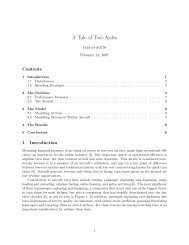Neural Models of Bayesian Belief Propagation Rajesh ... - Washington
Neural Models of Bayesian Belief Propagation Rajesh ... - Washington
Neural Models of Bayesian Belief Propagation Rajesh ... - Washington
You also want an ePaper? Increase the reach of your titles
YUMPU automatically turns print PDFs into web optimized ePapers that Google loves.
250 11 <strong>Neural</strong> <strong>Models</strong> <strong>of</strong> <strong>Bayesian</strong> <strong>Belief</strong> <strong>Propagation</strong> <strong>Rajesh</strong> P. N. Rao<br />
attention to nearby locations.<br />
All three types <strong>of</strong> response modulation described above can be explained in<br />
terms <strong>of</strong> <strong>Bayesian</strong> inference using the hierarchical graphical model for images<br />
given in section 11.2.3 (figure 11.3). Each V4 neuron is assumed to encode a<br />
feature Fi as its preferred stimulus. A separate group <strong>of</strong> neurons (e.g., in the<br />
parietal cortex) is assumed to encode spatial locations (and potentially other<br />
spatiotemporal transformations) irrespective <strong>of</strong> feature values. Lower-level<br />
neurons (for example, in V2 and V1) are assumed to represent the intermediate<br />
representations Ci. Figure 11.3B depicts the corresponding network for<br />
neural belief propagation. Note that this network architecture mimics the division<br />
<strong>of</strong> labor between the ventral object processing ("what") stream and the<br />
dorsal spatial processing ("where") stream in the visual cortex [24].<br />
The initial firing rates <strong>of</strong> location- and feature-coding neurons represent<br />
prior probabilities P (L) and P (F ) respectively, assumed to be set by taskdependent<br />
feedback from higher areas such as those in prefrontal cortex. The<br />
input likelihood P (I = I ′ |C) is set to <br />
j wijIj, where the weights wij represent<br />
the attributes <strong>of</strong> Ci (specific feature at a specific location). Here, we set<br />
these weights to spatially localized oriented Gabor filters. equation (11.11) and<br />
(11.12) are assumed to be computed by feedforward neurons in the locationcoding<br />
and feature-coding parts <strong>of</strong> the network, with their synapses encoding<br />
P (C|L, F ). Taking the logarithm <strong>of</strong> both sides <strong>of</strong> equations (11.13-11.15),<br />
we obtain equations that can be computed using leaky integrator neurons as<br />
in equation (11.32) (f and g are assumed to approximate a logarithmic transformation).<br />
Recurrent connections in equation (11.32) are used to implement<br />
the inhibitory component corresponding to the negative logarithm <strong>of</strong> the normalization<br />
constants. Furthermore, since the membrane potential vi(t) is now<br />
equal to the log <strong>of</strong> the posterior probability, i.e., vi(t) = log P (F |I = I ′ ) (and<br />
similarly for L and C), we obtain, using equation (11.33):<br />
P (feature coding neuron i spikes at time t) ∝ P (F |I = I ′ ) (11.45)<br />
This provides a new interpretation <strong>of</strong> the spiking probability (or instantaneous<br />
firing rate) <strong>of</strong> a V4 neuron as representing the posterior probability <strong>of</strong> a preferred<br />
feature in an image (irrespective <strong>of</strong> spatial location).<br />
To model the three primate experiments discussed above [4, 23, 36], we used<br />
horizontal and vertical bars that could appear at nine different locations in the<br />
input image (figure 11.8A). All results were obtained using a network with a<br />
single set <strong>of</strong> parameters. P (C|L, F ) was chosen such that for any given value<br />
<strong>of</strong> L and F , say location Lj and feature Fk, the value <strong>of</strong> C closest to the combination<br />
(Lj, Fk) received the highest probability, with decreasing probabilities<br />
for neighboring locations (see figure 11.8B).<br />
Multiplicative Modulation <strong>of</strong> Responses<br />
We simulated the attentional task <strong>of</strong> McAdams and Maunsell [23] by presenting<br />
a vertical bar and a horizontal bar simultaneously in an input image. “Attention”<br />
to a location Li containing one <strong>of</strong> the bars was simulated by setting
















